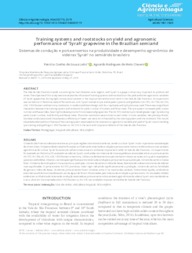Training systems and rootstocks on yield and agronomic performance of Syrah grapevine in the Brazilian Semiarid.
Training systems and rootstocks on yield and agronomic performance of Syrah grapevine in the Brazilian Semiarid.
Author(s): LEAO, P. C. de S.; CHAVES, A. R. de M.
Summary: The Vale do São Francisco stands out among the main Brazilian wine regions, and ?Syrah? is a grape cultivar very important to produce red wines. The objective of this study was to evaluate the influence of training systems and rootstocks on the yield and other agronomic variables of ?Syrah? grapevines during eight consecutive harvests in the tropical semiarid environment in the Vale do São Francisco. An experiment was carried out in Petrolina, state of Pernambuco, with ?Syrah? trained to lyre and espalier systems and grafted on IAC 572, IAC 766, IAC 313, SO4, 1103 Paulsen and Harmony rootstocks. A randomized block design with four replicates and split plots was used. There was a significant interaction between the training system and rootstock for yield, number of clusters and foliar mass. The lyre system increased yield, cluster number and Ravaz index, favoring the development of more balanced grapevines. The IAC 572 rootstock promoted greater vigor by reducing yield, cluster number, bud fertility and Ravaz index. The other rootstocks were similar to each other in most variables. Net photosynthesis, stomatal conductance and instantaneous efficiency of water use were not influenced by the training system and the rootstock. The results obtained evidenced the influence of the training system associated to the rootstock on agronomic variable and yield of ?Syrah?, recommending lyre training and grafting on 1103 Paulsen or IAC 313 in the semi-arid tropical conditions of the Vale do São Francisco.
Publication year: 2019
Types of publication: Journal article
Unit: Embrapa Semi-arid Region
Observation
Some of Embrapa's publications are published as ePub files. To read them, use or download one of the following free software options to your computer or mobile device. Android: Google Play Books; IOS: iBooks; Windows and Linux: Calibre.
Access other publications
Access the Agricultural Research Database (BDPA) to consult Embrapa's full library collection and records.
Visit Embrapa Bookstore to purchase books and other publications sold by Embrapa.

